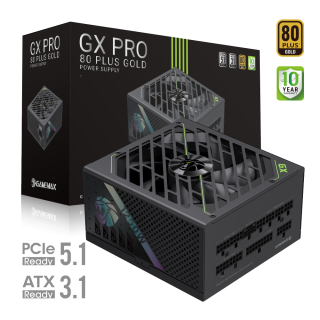When it comes to pairing a 50-series GPU with a power supply unit (PSU), the decision between ATX 3.0 and ATX 3.1 hinges on understanding their technical differences, the power demands of your GPU, and your long-term hardware plans. Here's a comprehensive breakdown to help you make an informed choice:

Key Features:
Introduced the 12VHPWR connector (12V High Power) for PCIe 5.0 GPUs, supporting up to 600W of power delivery.
Enhanced transient response to handle sudden power spikes (e.g., GPU boost phases) with 200% dynamic load support for 100 microseconds.
Stricter voltage hold-up time requirements (17ms at 100% load) to ensure stability during power outages.
Use Case: Ideal for RTX 40-series GPUs and early 50-series cards with moderate power demands.
Key Improvements:
12V-2x6 connector: A revised 16-pin design with longer power pins (4.45mm vs. 4.2mm) and shorter signal pins (2.75mm vs. 4mm) to prevent overheating due to loose connections. This addresses the 12VHPWR melting issue reported with RTX 4090s .
Power modes: Added 150W and 300W output modes for better compatibility with lower-power GPUs.
Relaxed hold-up time: Reduced from 17ms to 12ms at 100% load, making it easier for manufacturers to comply while maintaining efficiency .
Use Case: Best suited for high-end 50-series GPUs (e.g., RTX 5090 with 575W TDP) and future PCIe 5.1 hardware.
12V-2x6 Connector: The redesigned connector in ATX 3.1 ensures a secure fit and prevents overheating, critical for 50-series GPUs that draw massive transient power (e.g., RTX 5090’s 720W peak).
PCIe 5.1 Compliance: ATX 3.1 aligns with PCIe 5.1 standards, which may become mandatory for next-gen GPUs.
Manufacturer Recommendations: Brands like Corsair and Seasonic explicitly recommend ATX 3.1 for 50-series GPUs to avoid compatibility issues .
Existing 12VHPWR Compatibility: Many ATX 3.0 PSUs (e.g., Seasonic Vertex, Corsair RMx) use 12V-2x6 cables via firmware updates or modular designs, effectively functioning as ATX 3.1 units .
Power Redundancy: A high-wattage ATX 3.0 PSU (e.g., 1000W+) can handle 50-series GPUs if it meets the 600W 12VHPWR requirement and has robust transient response.
Opt for ATX 3.1: Choose PSUs like Corsair RM1000e (80+ Gold) or Seasonic FOCUS GX-850 (80+ Gold) for native 12V-2x6 support and future-proofing. These models often include 10-year warranties and advanced cooling features .
Example Build:
GPU: RTX 5090 (575W TDP)
PSU: Corsair HXi 1200W (ATX 3.1, 80+ Titanium)
Benefit: 12V-2x6 connector, 1200W headroom for overclocking, and silent operation.
Check Your PSU’s Specs:
Connector Type: Ensure your PSU has a 12VHPWR connector labeled “H++” (compatible with 12V-2x6) .
Power Rating: For RTX 5090, a 1000W+ ATX 3.0 PSU with 600W 12VHPWR support (e.g., EVGA SuperNOVA 1000W) is sufficient.
Testing: Use tools like OCCT to stress-test your PSU under load and monitor voltage stability .
ATX 3.0 Alternatives: Models like Thermaltake Toughpower GF1 750W (80+ Gold) or Cooler Master V750 (80+ Gold) offer 12VHPWR support at lower prices, though they lack ATX 3.1’s connector improvements .
Trade-offs: Higher risk of connector issues if cables aren’t fully seated.
Next-Gen GPUs: ATX 3.1’s 12V-2x6 connector is likely to become the standard for PCIe 5.1 hardware, ensuring compatibility with 60-series GPUs.
Efficiency: ATX 3.1 PSUs like Seasonic PRIME TX-1600 (80+ Titanium) achieve 94% efficiency, reducing energy costs over time .
Modular Design: Full modularity (e.g., Corsair HX1000i) simplifies cable management and reduces clutter in compact cases.
Avoid Adapters: Skip Molex-to-12VHPWR adapters, as they increase resistance and fire risks.
Check Certifications: Look for 80+ Gold/Platinum efficiency and PCIe 5.1 compliance labels.
Read Reviews: Platforms like Tom’s Hardware and AnandTech provide detailed PSU reviews, highlighting transient response and build quality.
ATX 3.1 is Recommended for 50-series GPUs, especially flagship models like the RTX 5090, due to its safer 12V-2x6 connector and future-proofing benefits.
ATX 3.0 is Acceptable if your PSU is high-quality (e.g., Seasonic Vertex, Corsair RMx) and meets the power demands of your GPU.
Invest in Quality: Regardless of the standard, prioritize reputable brands and wattage redundancy to ensure stability and longevity.
By understanding the technical nuances and aligning your choice with your hardware needs, you can ensure a reliable and efficient power supply for your 50-series GPU.

GX PRO 1250G 80 Plus Gold Modular Power Supply: ATX3.1 Ready, Silent Cooling, & Premium Durability
• 80 Plus Gold Efficiency & Quiet Operation: Achieves 90% efficiency under typical loads with APFC+LLC+DC-DC design, minimizing power waste and noise.
• Premium Durability & Reliability: Built with Japanese 105°C capacitors and solid capacitors for long-term stability and performance.
• ATX3.1 & PCIe5.1 Ready: Features a native 12V-2x6 connector for seamless RTX 40/50 GPU compatibility and efficient power delivery.
• Advanced Thermal Management: 13.5cm FDB fan with intelligent temperature control ensures quiet cooling and optimal heat dissipation.
• Modular Design & Robust Protection: Fully modular layout with dual-stage EMI filtering and NTC thermistor safeguards against surges, while gold-plated cables ensure durable, high-conductivity connections.